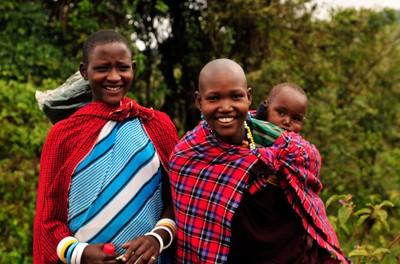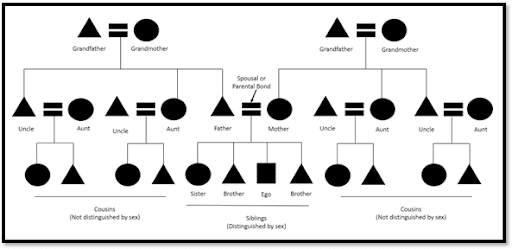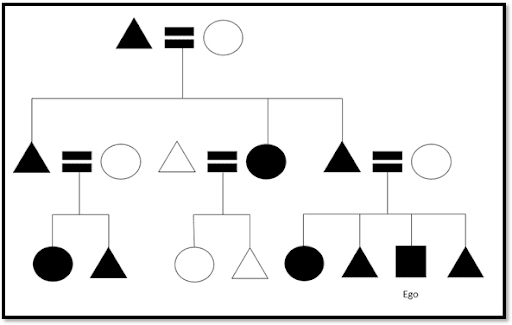8.2 Rights, Responsibilities, Statuses, and Roles in Families
Some of the earliest research in cultural anthropology explored differences in ideas about family. Lewis Henry Morgan, a lawyer who also conducted early anthropological studies of Native American cultures, documented the words used to describe family members in the Iroquois language.[1] In the book Systems of Consanguinity and Affinity of the Human Family (1871), he explained that words used to describe family members, such as “mother” or “cousin,” were important because they indicated the rights and responsibilities associated with particular family members both within households and the larger community. This can be seen in the labels we have for family members—titles like father or aunt—that describe how a person fits into a family as well as the obligations he or she has to others.
The concepts of status and role are useful for thinking about the behaviors that are expected of individuals who occupy various positions in the family. The terms were first used by anthropologist Ralph Linton, and they have since been widely incorporated into social science terminology.[2] For anthropologists, status is any culturally designated position a person occupies in a particular setting. Within the setting of a family, many statuses can exist such as “father,” “mother,” “maternal grandparent,” and “younger brother.” Of course, cultures may define the statuses involved in a family differently. A role is the set of behaviors expected of an individual who occupies a particular status. A person who has the status of “mother,” for instance, would generally have the role of caring for her children.
Roles, like statuses, are cultural ideals or expectations, and there will be variations in how individuals meet these expectations. Statuses and roles also change within cultures over time. In the not-so-distant past in the United States, the roles associated with the status of “mother” in a typical Euro-American middle-income family included caring for children and keeping a house; they probably did not include working for wages outside the home. It was rare for fathers to engage in regular, day-to-day housekeeping or childcare roles, though they sometimes “helped out,” to use the jargon of the time. Today, it is much more common for a father to be an equal partner in caring for children or a house or to sometimes take a primary role in child and house care as a “stay-at-home father” or as a “single father.” The concepts of status and role help us think about cultural ideals and what the majority within a cultural group tends to do. They also help us describe and document culture change. With respect to family and marriage, these concepts help us compare family systems across cultures.
8.2.1 Kinship and Descent
Provide an anthropological definition of kinship using your own words. How does this compare to the definition of kinship you have been using as a layperson? Kinship is the word used to describe culturally recognized ties between members of a family. Kinship includes the terms, or social statuses, used to define family members and the roles or expected behaviors family associated with these statuses. Kinship encompasses relationships formed through blood connections (consanguineal), such as those created between parents and children, as well as relationships created through marriage ties (affinal), such as in-laws (see Figure 1). Kinship can also include “fictive kin”, also known as chosen kin who have no formal blood or marriage ties, but consider themselves to be family. Adoptive parents, for instance, are culturally recognized as parents to the children they raise even though they are not related by blood. Close friends can also serve as chosen kin depending on the level of closeness.

Other examples of fictive kinship relationships can include foster families, blood brothers/sisters, god-parents, nurture kinship, athlete/coach relationships, as well as student/teacher relationships. Immigrant groups may form with unrelated people within their community who share a cultural or ethnic background. Such communities provide financial, social, and other support and function in many ways as fictive extended families. For example, my family (Demetri) was part of the Aristomenis Messinian Benevolent Society, which would hold festivals, raffles, cultural events and even provided members, including myself, with small grants to help with college expenses.
While there is quite a bit of variation in families cross-culturally, it is also true that many families can be categorized into broad types based on what anthropologists call a kinship system. The kinship system refers to the pattern of culturally recognized relationships between family members. Some cultures create kinship through only a single parental line or “side” of the family. For instance, families in many parts of the world are defined by patrilineal descent : the paternal line of the family, or fathers and their children. In other societies, matrilineal descent defines membership in the kinship group through the maternal line of relationships between mothers and their children. Both kinds of kinship are considered unilineal because they involve descent through only one line or side of the family. It is important to keep in mind that systems of descent define culturally recognized “kin,” but these rules do not restrict relationships or emotional bonds between people. Mothers in patrilineal societies have close and loving relationships with their children even though they are not members of the same patrilineage.[3] In the United States, for instance, last names traditionally follow a pattern of patrilineal descent: children receive last names from their fathers. This does not mean that the bonds between mothers and children are reduced. Bilateral descent is another way of creating kinship. Bilateral descent means that families are defined by descent from both the father’s and the mother’s sides of the family. In bilateral descent, which is common in the United States, children recognize both their mother’s and father’s family members as relatives.
As we will see below, the descent groups that are created by these kinship systems provide members with a sense of identity and social support. Kinship groups may also control economic resources and dictate decisions about where people can live, who they can marry, and what happens to their property after death.
Anthropologists use kinship diagrams to help visualize descent groups and kinship. Figure 8.2 is a simple example of a kinship diagram that uses bilateral descent, meaning that both sides of the family are considered family.

Here is a video to assist you in thinking about and using kinship system structures:
Kinship diagrams use a specific person, who by convention is called Ego, as a starting point. The people shown on the chart are Ego’s relatives. In Figure 8.2, Ego is in the middle of the bottom row. Figure 8.2 shows a diagram of three generations of a typical bilateral (two sides) kinship group, focused on parents and children, with aunts, uncles, cousins, grandparents, and grandchildren. Note that everyone in the diagram is related to everyone else in the diagram, even though they may not interact on a regular basis. The group could potentially be very large, and everyone related through blood, marriage, or adoption is included.
How to read a kinship system diagram:
- ▲= males, ◯ = females, ◼ = nonbinary person
- An “equals sign” placed between two individuals indicates a marriage.
- A single line, or a hyphen, can be used to indicate a recognized union without marriage, such as a couple living together or engaged and living together, sometimes with children.
- Children are linked to their parents by a vertical line that extends down from the equals sign.
- A sibling group is represented by a horizontal line that encompasses the group. Usually children are represented from left to right–oldest to youngest.
- Other conventions for these charts include darkening the symbol or drawing a diagonal line through the symbol to indicate that a person is deceased.
- A diagonal line may be drawn through the equals sign if a marriage has ended, for example, in divorce.
- Please note that symbols used to create kinship diagrams, especially those that depict relationships between individuals and genders, are very diverse and can be freely altered and adapted to fit the needs of a particular social group.
The next two kinship diagrams show how the descent group changes in unilineal kinship systems like a patrilineal system (father’s line) or a matrilineal system (mother’s line). The roles of the family members in relationship to one another are also likely to be different because descent is based on lineage: descent from a common ancestor. In a patrilineal system, children are always members of their father’s lineage group (Figure 8.3). In a matrilineal system, children are always members of their mother’s lineage group (Figure 8.4). In both cases, individuals remain a part of their birth lineage throughout their lives, even after marriage. Typically, people must marry someone outside their own lineage. In Figures 8.3 and 8.4, the shaded symbols represent people who are in the same lineage. The unshaded symbols represent people who have married into the lineage.
In general, bilateral kinship is more focused on individuals rather than a single lineage of ancestors as seen in unilineal descent. Each person in a bilateral system has a slightly different group of relatives. For example, my brother’s relatives through marriage (his in-laws) are included in his kinship group,
but are not included in mine. His wife’s siblings and children are also included in his group but not in mine. If we were in a patrilineal or matrilineal system, my brother and I would largely share the same group of relatives.

Matrilineages and patrilineages are not just mirror images of each other. They create groups that behave somewhat differently. Contrary to some popular ideas, matrilineages are not matriarchal. The terms “matriarchy” and “patriarchy” refer to the power structure in a society. In a patriarchal society, men have more authority and the ability to make more decisions than women. A father may have the right to make certain decisions for his wife or wives and for his children or any other dependents. In matrilineal societies, men usually still have greater power, but women may be subject more to the power of their brothers or uncles (relatives through their mother’s side of the family) rather than their fathers.
Power is shared among the genders differently: The Hopi & The Nayar as case studies
Among the matrilineal Hopi, for example, a mother’s brother is more likely to be a figure of authority than a father. The mother’s brothers have important roles in the lives of their sisters’ children. These roles include ceremonial obligations and the responsibility to teach the skills that are associated with men and men’s activities. Men are the keepers of important ritual knowledge so while women are respected, men are still likely to hold more authority.
The Nayar of southern India offer an interesting example of gender roles in a matrilineal society. In the seventeenth and eighteenth centuries, men and women did not live together after marriage because the husbands, who were not part of the matrilineage, were not considered relatives. Women lived for their entire lives in extended family homes with their mothers and siblings. The male siblings in the household had the social role of father and were important father figures in the lives of their sisters’ children. The biological fathers of the children had only a limited role in their lives. Instead, these men were busy raising their own sisters’ children. Despite the matrilineal focus of the household, Nayar communities were not matriarchies. The position of power in the household was held by an elder male, often the oldest male sibling.

The consequences of this kind of matrilineal system are intriguing. Men did not have strong ties to their biological offspring. Marriages were fluid and men and women could have more than one spouse, but the children always remained with their mothers. [4] Cross-culturally, it does seem to be the case that in matrilineal societies women tend to have more freedom to make decisions about sex and marriage. Children are members of their mother’s kinship group, whether the mother is married or not, so there is often less concern about the social legitimacy of children or fatherhood.
Are marriages less stable in matrilineal societies than in patriarchal ones? Anthropologists are not in agreement
Among the matrilineal Iroquois, for example, women owned the longhouses. Men moved into their wives’ family houses at marriage. If a woman wanted to divorce her husband, she could simply put his belongings outside. In that society, however, men and women also spent significant time apart. Men were hunters and warriors, often away from the home. Women were the farmers and tended to the home. This, as much as matrilineality, could have contributed to less formality or disapproval of divorce. There was no concern about the division of property. The longhouse belonged to the mother’s family, and children belonged to their mother’s clan. Men would always have a home with their sisters and mother, in their own matrilineal longhouse.[5]
Kinship charts can be useful when doing field research and particularly helpful when documenting changes in families over time. It is easy to document changes that occurred in a relatively short time, likely linked to urbanization, such as changes in family size, in prevalence of divorce, and in increased numbers of unmarried adults. Creating kinship charts can be useful in field research and could be given as gifts to participants.
Reading Check-in: Create your own kinship chart and share it as an image, or pic, or pdf for all of us to see – Make sure to do labels to show knowledge.
Media Attributions
- Maasai women © Laura Tubelle de González is licensed under a All Rights Reserved license
- Kinship chart © LibreTexts is licensed under a CC BY-NC (Attribution NonCommercial) license
- Kinship chart with Ego in father’s lineage © LibreTexts is licensed under a CC BY-NC (Attribution NonCommercial) license
- Kinship chart with Ego in mother’s lineage © LibreTexts is licensed under a CC BY-NC (Attribution NonCommercial) license
- Lewis Henry Morgan, Systems of Consanguinity and Affinity of the Human Family (Washington D.C.: Smithsonian Institution, 1871). ↵
- Ralph Linton, The Study of Man (New York: D. Appleton-Century Company,1936). ↵
- In a patrilineal society, children are members of their father’s patrilineage. A mother belongs to her own father’s patrilineage, while the children belong to their father’s patrilineage. ↵
- Kathleen Gough, “Variation in Matrilineal Systems,” in D. Schneider and K. Gough, eds., Matrilineal Kinship, Part 2 (Berkeley: University of California Press, 1961). See also Kathleen Gough, The Traditional Kinship System of the Nayars of Malabar (Cambridge, MA: Harvard University Press, 1954). ↵
- See for example Merlin Myers, Households and Families of the Longhouse Iroquois at Six Nations Reserve (Lincoln, NE: University of Nebraska Press, 2006). ↵
blood ties, common ancestry, and social relationships that form families within human groups.
a kinship group created through the paternal line (fathers and their children).
a kinship group created through the maternal line (mothers and their children).
descent is recognized through both the father’s and the mother’s sides of the family.
relationships that provide members with a sense of identity and social support based on ties of shared ancestry.
charts used by anthropologists to visually represent relationships between members of a kinship group.
a society in which women have authority to make decisions.

